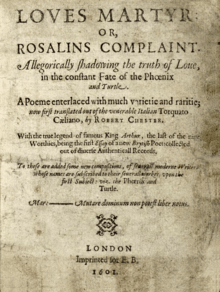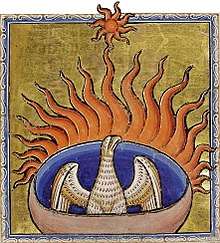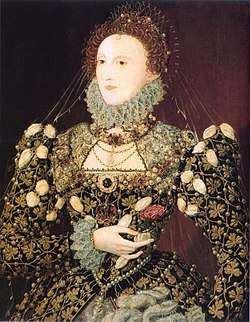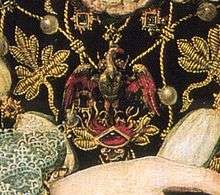The Phoenix and the Turtle
The Phoenix and the Turtle (also spelled The Phœnix and the Turtle) is an allegorical poem about the death of ideal love by William Shakespeare. It is widely considered to be one of his most obscure works and has led to many conflicting interpretations.[1] It has also been called "the first great published metaphysical poem".[2] The title "The Phoenix and the Turtle" is a conventional label. As published, the poem was untitled. The "turtle" is the turtle dove, not the shelled reptile.

The poem describes a funeral arranged for the deceased Phoenix and Turtledove, respectively emblems of perfection and of devoted love. Some birds are invited, but others excluded. It goes on to state that the love of the birds created a perfect unity which transcended all logic and material fact. It concludes with a prayer for the dead lovers.
Context

It was first published in 1601 as a supplement to a long poem by Robert Chester, entitled Love's Martyr. The full title of Chester's book explains the content:
- Love's Martyr: or Rosalins Complaint. Allegorically shadowing the truth of Loue, in the constant Fate of the Phoenix and Turtle. A Poeme enterlaced with much varietie and raritie; now first translated out of the venerable Italian Torquato Caeliano, by Robert Chester. With the true legend of famous King Arthur the last of the nine Worthies, being the first Essay of a new Brytish Poet: collected out of diuerse Authenticall Records. To these are added some new compositions of seuerall moderne Writers whose names are subscribed to their seuerall workes, vpon the first subiect viz. the Phoenix and Turtle.
Chester prefaced his poem with a short dedication addressed to the Phoenix and Turtledove. The Phoenix is envisaged as female and the dove as male:
- Phoenix of beautie, beauteous, Bird of any
- To thee I do entitle all my labour,
- More precious in mine eye by far then many
- That feedst all earthly sences with thy savour:
- Accept my home-writ praises of thy love,
- And kind acceptance of thy Turtle-dove
Chester's main poem is a long allegory in which the relationship between the birds is explored, and its symbolism articulated. It incorporates the story of King Arthur, and a history of ancient Britain, emphasising Welsh etymologies for British towns. It culminates with the joint immolation of the Phoenix and Turtledove, giving birth to a new and more beautiful bird from the ashes. It also includes several allegorical love poems within it, supposed to have been written by the Turtledove to the Phoenix.
It is followed by a brief collection of "Diverse Poeticall Essaies" by the "best and chiefest of our moderne writers, with their names sub-scribed to their particular workes". These include, in addition to Shakespeare, Ben Jonson, George Chapman, John Marston and the anonymous "Vatum Chorus" and "Ignoto". All use the same imagery. The poems are introduced by Vatum Chorus and Ignoto, followed by The Phoenix and the Turtle, which ends with mourning for the death of the perfect lovers, "leaving no posterity". Marston then seems to reply to Shakespeare's "moving epicedium", by referring to the couple's "glorious issue": the being born from the flames. Chapman adds more detail on the relationship, saying that the Phoenix provided every variety of life to the Turtle, "She was to him the Analysed World of pleasure, / Her firmness cloth'd him in variety". Jonson ends with an idealisation of the Phoenix, whose judgement shines as "Clear as a naked Vestal, / Closed in an orb of Crystal."
Interpretations

In addition to an allegory of an ideal marriage, the poem can be seen as an elucidation of the relationship between truth and beauty, or of fulfilled love, in the context of Renaissance Neoplatonism.[3] It also seems that the roots of this conception of perfect love lie not only in scholastic sources regarding the union of persons in the Trinity, but also in the confluence of three other lines of medieval Catholic tradition: the literary traditions of mystical union, spiritual friendship, and spiritual marriage [4] Shakespeare introduces a number of other birds, drawing on earlier literature about the "parliament of birds", to portray the death of the lovers as the loss of an ideal that can only be lamented.
Several attempts have been made to link the lovers of the poem to historical individuals, though others have argued that the poem should not be interpreted with "appliqué literalism", in the words of James P. Bednarz.[5] Indeed, exponents of the New Criticism such as I. A. Richards and William Empson emphasised the unresolvable nature of the text's ambiguities.[5] Helen Hackett argues that the poem "invites deciphering, but at the same time firmly rebuff it."[6] Some of the more prominent attempted decodings of the allegory with reference to real individuals are listed below:
John and Ursula Salusbury
Because Chester dedicated the main poem to the Welsh statesman Sir John Salusbury and his wife Ursula Stanley, it has been argued that all the poems in the collection, including Shakespeare's, also celebrate the couple. Salusbury was a courtier at the court of Elizabeth I, and was a member of the powerful Salusbury Family of Wales. His wife Ursula was the illegitimate daughter of Henry Stanley, 4th Earl of Derby. A difficulty with this view is the fact that the couple are known to have had ten children, but the poem refers to the relationship as a childless "married chastity". This is commented on elsewhere in the collection by John Marston, and all the poems in the collection emphasise the chaste and spiritual nature of the relationship, the couple's only child being the mysterious being born from their bodily deaths. The identification of the Salusburys as the subject was first argued in detail by Carleton Brown in 1913.[7] Brown tried to resolve the problem by arguing that it was written after the birth of the couple's first child, but not published until many years later. Later writers have sometimes argued that while Chester's Love's Martyr may be intended to celebrate the couple, Shakespeare's own poem does not. John Klause suggests that the "death" implied in Chester's work is symbolic of marriage and "sexual surrender", but in Shakespeare's poem death is literal.[8] G. Wilson Knight suggested that the poem celebrates chaste love because it is about Salusbury's devotion to his sister, for whom Salusbury himself had written a poem.[9]
Queen Elizabeth

An alternative is to interpret the Turtle as John Salusbury and the Phoenix as Queen Elizabeth I, which would explain the chastity of the relationship and the implication that their "child" is something mystical rather than physical. Elizabeth was often connected to the phoenix, and she is referred to as the "maiden phoenix" in the play Henry VIII, partly written by Shakespeare (though the "maiden phoenix" passage is typically attributed to John Fletcher). Two panel portraits attributed to Nicholas Hilliard are known as the "Phoenix" and "Pelican" portraits because of jewels the queen wears: her personal badges of the pelican and the phoenix. Both birds appear in Chester's main poem. An objection is that the intimacy between the lovers seems rather too strong for Salusbury and the queen.[5]
Katherine Duncan-Jones and Henry Woudhuysen adopt a variation of the view that the poem refers to Salusbury and the queen, arguing that the "session" mentioned in the poem is the 1601 parliament, in which Elizabeth made a famous speech about the symbolic relationship between herself and her people, sometimes referred to as her Farewell Speech.[10] They draw on the earlier work of Marie Axton, who argued that Elizabeth herself is both birds, in her monarchical and human aspects, but that the human aspect (the Turtle) also includes the body of the people as a whole. Duncan-Jones and Woudhuysen suggest that Salusbury represents the people.
Some scholars interpret the child of the phoenix as a reference to Elizabeth's heir, James VI of Scotland. This imagery was used in 1604, when James arrived in London, but this would have been problematic in 1601, when Elizabeth was still alive.[5]
The theory that both Chester's and Shakespeare's poems were intended to refer to the relationship between Elizabeth and Robert Devereux, Earl of Essex was first proposed by A.B. Grosart in 1878, and was revived by William Matchett in 1965.[11] Many authors who reject the identification of the lovers as Essex and Elizabeth nevertheless argue that the events of Essex's rebellion and execution in early 1601 may lie behind some of the more obscure symbolism in the poem and the others in the collection.[12] Sir John Salusbury had been knighted for helping to suppress the rebellion, while his cousin Owen Salusbury was killed while participating in it. Sir John's brother, Thomas Salusbury, had been executed after the earlier Babington Plot against Elizabeth. Duncan-Jones and Woudhuysen argue that Salusbury was "love's martyr" for putting devotion to his queen above his family.[6] Peter Ackroyd and James P. Bednarz both argue that Shakespeare may have written the poem to dissociate himself from Essex, with whom he was implicated because of his links to Essex's main ally the Earl of Southampton, and because his play about the overthrow of a monarch, Richard II, had been performed at the request of the rebels. For Bednarz "Shakespeare's name, subscribed to his poem in Love's Martyr shows his accommodation to the political order without endorsing any specific political position."[13]
Catholic martyrs
Another interpretation, first proffered in the 1930s by Clara Longworth in the novel My Shakespeare, Rise! is that the poem is a cryptic Roman Catholic eulogy and is part of the contention that Shakespeare was a secret Catholic sympathiser.[14] The advocacy of prayers for the dead ("these dead birds") in the final line of the poem corroborates this interpretation.[15] Several critics, including Clare Asquith and David Beauregard, have noted that the poem ostensibly references Catholic liturgy and possibly the writings of the Catholic priest and poet Rev. Robert Southwell, SJ, who translated the Latin hymn Lauda Sion and also authored a poem praising the married chastity of St. Mary and St. Joseph.[8] John Klause argued that the poem has various parallels to the Dies Irae of the Liturgy for the Dead, but suggests that its Catholic imagery satirises conventional Protestant attitudes expressed in Chester's poem, and that it is a subtle protest against the lauding of Sir John Salusbury, whose imagined death he supposes the poem celebrates.[8]
Proponents of the Catholic interpretation have suggested various identities for the poem's birds, but the interpretation that has the most traction is that the phoenix commemorates St. Anne Line, a Roman Catholic executed at Tyburn in 1601 and subsequently canonised by the Roman Catholic Church as a martyr.[16] St. Anne Line and her young husband Roger were separated when he was imprisoned and then exiled after being arrested at a prohibited Catholic Mass. He died on the European continent a few years later and St. Anne began working for the Jesuits in London. She was arrested at a Candlemas liturgy and convicted of harbouring a Catholic priest, which led to her execution. Her body was retrieved from the common grave in the road and one of the Jesuits who knew her hinted that a secret requiem Mass was later offered for her.[17] It was suggested that this requiem Mass provided the setting for Shakespeare's poem. The identification was corroborated by the belief that, like Shakespeare's couple, the Lines had no children. However, it has been proven since that they had a son named "John", whom relatives adopted.[18]
Clara Longworth first suggested that St. Anne Line is Shakespeare's phoenix and Mark Barkworth, a Catholic priest who reportedly embraced her body as it hung on the scaffold before he was also executed, is the turtle.[14] John Finnis and Patrick Martin argued more recently that St. Anne Line is the phoenix and her husband Roger is the turtle.[19] They concur with Clare Asquith that the "bird of loudest lay" represents the composer William Byrd, who was a Roman Catholic convert, and that the crow is the Catholic priest Rev. Henry Garnet, SJ.[20] Martin Dodwell argued further that Shakespeare used St. Anne and Roger Line to symbolise the Catholic Church itself, as disinherited and rejected by England.[17]
Text of the poem
The Phoenix and the Turtle
Let the bird of loudest lay,
On the sole Arabian tree,
Herald sad and trumpet be,
To whose sound chaste wings obey.
But thou, shrieking harbinger,
Foul pre-currer of the fiend,
Augur of the fever's end,
To this troop come thou not near.
From this session interdict
Every fowl of tyrant wing,
Save the eagle, feather'd king:
Keep the obsequy so strict.
Let the priest in surplice white,
That defunctive music can,
Be the death-divining swan,
Lest the requiem lack his right.
And thou, treble-dated crow,
That thy sable gender mak'st
With the breath thou giv'st and tak'st,
'Mongst our mourners shalt thou go.
Here the anthem doth commence:
Love and constancy is dead;
Phoenix and the turtle fled
In a mutual flame from hence.
So they lov'd, as love in twain
Had the essence but in one;
Two distincts, division none:
Number there in love was slain.
Hearts remote, yet not asunder;
Distance, and no space was seen
'Twixt the turtle and his queen;
But in them it were a wonder.
So between them love did shine,
That the turtle saw his right
Flaming in the phoenix' sight:
Either was the other's mine.
Property was thus appall'd,
That the self was not the same;
Single nature's double name
Neither two nor one was call'd.
Reason, in itself confounded,
Saw division grow together;
To themselves yet either-neither,
Simple were so well compounded
That it cried how true a twain
Seemeth this concordant one!
Love hath reason, reason none
If what parts can so remain.
Whereupon it made this threne
To the phoenix and the dove,
Co-supreme and stars of love;
As chorus to their tragic scene.
THRENOS.
Beauty, truth, and rarity.
Grace in all simplicity,
Here enclos'd in cinders lie.
Death is now the phoenix' nest;
And the turtle's loyal breast
To eternity doth rest,
Leaving no posterity:--
'Twas not their infirmity,
It was married chastity.
Truth may seem, but cannot be:
Beauty brag, but 'tis not she;
Truth and beauty buried be.
To this urn let those repair
That are either true or fair;
For these dead birds sigh a prayer.
References
- Oxford Anthology of Literature of Renaissance England, J. Holander, F. Kermode (eds), OUP, 1973, p. 424.
- James P. Bednarz in Cheney, Patrick Gerard The Cambridge Companion to Shakespeare's Poetry, Cambridge University Press, 2007, p117
- Zezmer, D.M., Guide to Shakespeare, 1976, New York, p. 88
- Beauregard, David (2011). "'The Mutual Flame of Love': Spiritual Marriage in Shakespeare's The Phoenix and Turtle". Religion and the Arts. 15 (1–2): 131–147. doi:10.1163/156852911X547501.
- James P. Bednarz, Shakespeare and the Truth of Love: The Mystery of 'The Phoenix and Turtle', Palgrave Macmillan, 2012.
- Helen Hackett, Shakespeare and Elizabeth: The Meeting of Two Myths, Princeton University Press, 2009, p. 136.
- Poems by Sir John Salusbury and Robert Chester by Carleton Brown.
- John Klause, "The Phoenix and the Turtle in its Time", in Gwynne Blakemore Evans (ed), In the Company of Shakespeare: Essays on English Renaissance Literature, Fairleigh Dickinson Univ Press, 2002, pp. 206–227.
- William Empson, Essays on Shakespeare, Cambridge University Press, 1986, p. 20.
- Duncan-Jones and Woudhuyson, Shakespeare's Poems, Arden Shakespeare, Cengage Learning EMEA, 2007, p.421ff.
- Harrison, Thomas P. (1966). "The Phoenix and the Turtle: Shakespeare's Poem and Chester's Loues Martyr reviewed by William H. Matchett". Modern Philology. 64 (2): 155–157. doi:10.1086/389840.
- John Finnis and Patrick Martin, "Another turn for the Turtle", The Times Literary Supplement, 18 April 2003
- James P. Bednarz, p. 72.
- Longworth, Clara, My Shakespeare, Rise!, London: 1935.
- David Beauregard, pp. 141–144.
- See the discussion in Shakespeare's Poems in Arden Shakespeare Series, 93–94.
- Martin Dodwell, Anne Line: Shakespeare's Tragic Muse (Brighton: The Book Guild, 2013).
- Christine J. Kelly, “Anne Line [St Anne Line] (d. 1601)”, ODNB, online edition, January 2009, http://www.oxforddnb.com/view/article/69035, accessed 3 November 2013.
- Times Literary Supplement, 18 April 2003, pp. 12–14.
- Asquith, Clare, Shakespeare Newsletter, 50, 2001.
Bibliography
- Gillham, Christiane (1992). "'Single Nature's Double Name': Some Comments on The Phoenix and Turtle". Connotations. 2 (2): 126–136.CS1 maint: ref=harv (link)
- Gillham, Christiane (1993–1994). "Single Natures–Double Name: A Reply to Peter Milward and James H. Sims". Connotations. 3 (2): 123–128.CS1 maint: ref=harv (link)
- Kerrigan, John (2013a). "Reading 'The Phoenix and Turtle'". In Post, Jonathan (ed.). Oxford Handbook of Shakespeare's Poetry. Oxford: Oxford University Press. pp. 540–559. ISBN 978-0198778011.CS1 maint: ref=harv (link)
- Kerrigan, John (2013b). "Shakespeare, Elegy and Epitaph: 1557–1640". In Post, Jonathan (ed.). Oxford Handbook of Shakespeare's Poetry. Oxford: Oxford University Press. pp. 225–244. ISBN 978-0198778011.CS1 maint: ref=harv (link)
- Milward, Peter (1993–1994). "'Double Nature's Single Name': A Response to Christiane Gillham". Connotations. 3 (1): 60–63.CS1 maint: ref=harv (link)
- Sims, James H. (1993–1994). "Shakespeare's 'The Phoenix and the Turtle': A Reconsideration of 'Single Natures Double Name'". Connotations. 3 (1): 64–71.CS1 maint: ref=harv (link)
- Straumann, Heinrich (1977). "'The phoenix and the turtle' in its dramatic context". English Studies. 58 (6): 494–500. doi:10.1080/00138387708597857.CS1 maint: ref=harv (link)
External links
- The Phoenix and the Turtle at Project Gutenberg

- Digital facsimile of poem from Folger Shakespeare Library
- Robert Chester's Love's martyr, or, Rosalins complaint (1601) : with its supplement "Diverse poeticall essaies" on the Turtle and Phoenix at Internet Archive
- Public domain recording of the poem at archive.org
- Partial bibliography for Clifford Stetner's PhD dissertation Shakespeare's Shrieking Harbinger: The Phoenix and the Turtle, the First Folio, and the Shapes of Time}

.png)